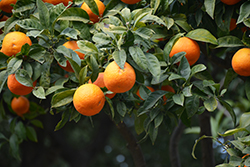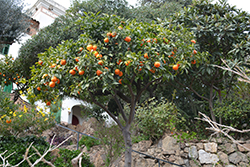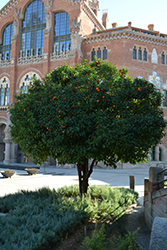It's all about ...
plants

Height: 30 feet
Spread: 20 feet
Sunlight:
![]()
![]()
Hardiness Zone: 8b
Other Names: Seville Orange, Sour Orange,
Description:
Attractive deep green foliage on a dense, shrubby habit; fragrant flowers produce yellow-orange fruit that is bitter and can be used for preserves, but is primarily used in oil production; protect from frost
Edible Qualities
Bitter Orange is a medium-sized tree that is commonly grown for its edible qualities. It produces orange oval fruit with yellow overtones which are usually ready for picking from early to mid winter. The fruits have a bitter taste.
The fruit are most often used in the following ways:
- Eating When Cooked/Prepared
- Preserves
Features & Attributes
Bitter Orange features showy clusters of fragrant white star-shaped flowers with buttery yellow eyes at the ends of the branches from late spring to mid summer. It has attractive dark green evergreen foliage. The glossy oval leaves are highly ornamental and remain dark green throughout the winter. It produces orange berries with yellow overtones from early to mid winter. The fruit can be messy if allowed to drop on the lawn or walkways, and may require occasional clean-up.
This is a multi-stemmed evergreen tree with an upright spreading habit of growth. Its average texture blends into the landscape, but can be balanced by one or two finer or coarser trees or shrubs for an effective composition. This is a relatively low maintenance plant, and is best pruned in late winter once the threat of extreme cold has passed. It is a good choice for attracting birds, bees and butterflies to your yard. It has no significant negative characteristics.
Aside from its primary use as an edible, Bitter Orange is sutiable for the following landscape applications;
- Accent
- Hedges/Screening
- Orchard/Edible Landscaping
- Container Planting
Planting & Growing
Bitter Orange will grow to be about 30 feet tall at maturity, with a spread of 20 feet. It has a low canopy with a typical clearance of 3 feet from the ground, and is suitable for planting under power lines. It grows at a medium rate, and under ideal conditions can be expected to live for 50 years or more.
This plant is typically grown in a designated edibles garden. It does best in full sun to partial shade. It prefers to grow in average to moist conditions, and shouldn't be allowed to dry out. It is not particular as to soil type or pH. It is somewhat tolerant of urban pollution. This species is not originally from North America.
Bitter Orange is a good choice for the edible garden, but it is also well-suited for use in outdoor pots and containers. Its large size and upright habit of growth lend it for use as a solitary accent, or in a composition surrounded by smaller plants around the base and those that spill over the edges. It is even sizeable enough that it can be grown alone in a suitable container. Note that when grown in a container, it may not perform exactly as indicated on the tag - this is to be expected. Also note that when growing plants in outdoor containers and baskets, they may require more frequent waterings than they would in the yard or garden. Be aware that in our climate, most plants cannot be expected to survive the winter if left in containers outdoors, and this plant is no exception. Contact our experts for more information on how to protect it over the winter months.
This plant is not reliably hardy in our region, and certain restrictions may apply; contact the store for more information.


